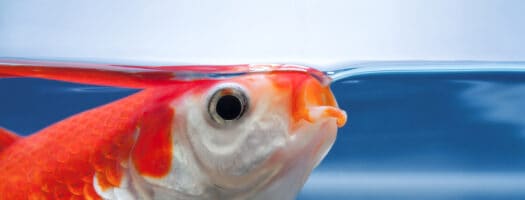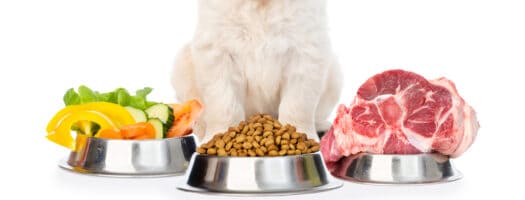The 10 Best Cichlid Food in 2025
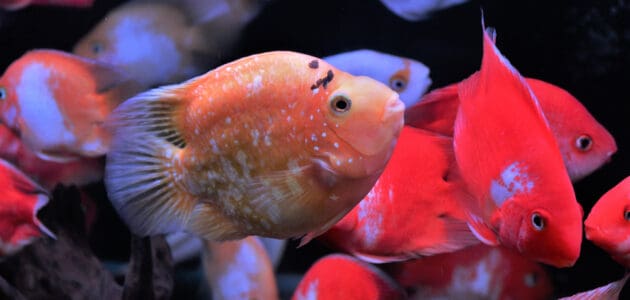
Cichlids are some of the most well-known and sought after fish in the hobby, both by amateurs and experts alike. This doesn’t come as a surprise, as they are some of the most diverse, beautiful, and interesting species of fish around.
Anyone would be proud to have such lively, colorful creatures on display in their aquarium, but caring for them isn’t always sunshine and rainbows. To raise happy cichlids, you need to consider several things – the most important of which is their diet.
In this article, we’ll tell you everything you need to know about feeding your beloved cichlids.
- Things to Consider When Buying Cichlid Food
- Top 10 Best Cichlid Foods 2025
- 1. Best Overall: Fluval Bug Bites Cichlid Fish Food
- 2. Best Premium Pick: TetraCichlid Balanced Diet Flakes
- 3. Best Budget Pick: API Fish Food Pellets
- 4. Best for Enhancing Color: Aqueon Cichlid Pellets
- 5. Best Crisps: TetraCichlid Cichlid Crisps
- 6. Best for Bottom Feeders: Omega One Super Color Sinking Cichlid Pellets
- 7. Best for Small Cichlids: NorthFin Cichlid
- 8. Best for Carnivores: Hikari Cichlid Gold Fish Food
- 9. Best Floating Sticks: TetraCichlid Floating Sticks
- 10. Most Unique Ingredients: New Life Spectrum Naturox Series Cichlid Formula
- The Ultimate Guide to Cichlid Food
- Final Thoughts
Things to Consider When Buying Cichlid Food
Before we jump to our list of the best cichlid foods, let’s take a look at some essential factors to consider first.
Natural Diet
Cichlids are very diverse in more ways than one. You may have noticed this because of their incredibly varied appearance, patterns, and colorations. What you probably didn’t know is that their diets differ just as much.
When it comes to diet, cichlids can be divided into three main types: the carnivores, the herbivores, and the omnivores. These fishes have distinct physical characteristics related to their special diets. These attributes and why they’re important will be discussed better further below.
Nutrient Balance
Out in the wild, most cichlids don’t have a single, specific diet. They are opportunistic creatures and aren’t very picky, usually eating whatever they can, whenever they can.
In fact, there are no strict divisions to a cichlid’s diet, even across diet types. For instance, while carnivorous cichlids thrive mostly on meat, they wouldn’t pass up nibbling on some tasty algae or greens once in a while, especially if they’re hungry.
Since cichlids are used to taking in varied nutrients in their wild habitats, you should emulate this in your tank as well and choose cichlid foods made of nutritionally balanced ingredients.
Food Type
Not all cichlid foods are created equal. They come in a wide variety of types such as flakes, pellets, tablets, live or frozen food, or freeze-dried food. These categories all have their own pros and cons, although some are better than others for various reasons.
To give you a thorough understanding of the types of cichlid food available, head over to its specific section below.
Now that you know what to look for, we’re going to take you through the ten best chichlid foods.
Top 10 Best Cichlid Foods 2025
1. Best Overall: Fluval Bug Bites Cichlid Fish Food
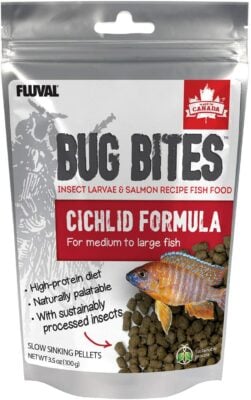
Editor’s Rating:
Why we like it: Fluval has been earning the trust of many aquarists for decades now, and their unique high-protein, high-carbohydrates, and nutrient-rich Fluval Bug Bites are a perfect example of why.
Quick Facts:
- Type: Pellets
- Buoyancy: Slow-sinking
- Food size: 5-7 mm
- Product weight: 100 grams; available in 46 g
- Diet type: Primarily carnivorous
Almost all varieties of cichlids love insects, and Fluval’s incredibly high-quality, insect-based cichlid food has been specially formulated for aggressive, highly active, and carnivorous fish species.
Fluval Bug Bites contain multiple proteins and are rich in Omega 6 and 3. It also doesn’t contain artificial preservatives that could potentially harm your beloved pets. All this makes your cichlid shine, promoting proper growth and repair of scales and fins and enhancing coloration.
However, not all the pellets sink when placed in the water. Also, the individual pellets of Bug Bites are much bigger compared to other medium and large pellets in the market. If you have smaller pets, it’s best to look at other products like the Omega One Super Color Sinking Cichlid Pellets or the NorthFin Cichlid Food. But other than that, there’s absolutely no reason for you not to go for this product.
Pros
- Natural ingredients
- Unique bug-based food
- No preservatives
- High protein nutrition
- Rich in Omega 3 and 6
Cons
- Much bigger than competitors
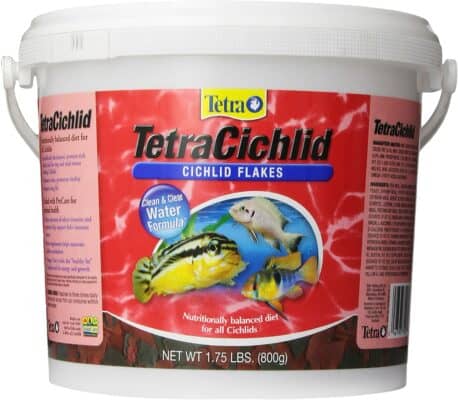
Editor’s Rating:
Why we like it: Tetra has been a fishkeepers’ producer of top-of-the-line products for 50 years now, and it’s easy to see why. Just take a look at these nutrient-rich, high-quality flakes perfect for cichlids of all shapes and sizes.
Quick Facts:
- Type: Flakes
- Buoyancy: Floating
- Food size: N/A
- Product weight: 800g; available in 160g, 80g, and 45g
- Diet type: Omnivorous
Tetra is easily one of the most recognizable names when it comes to aquarium-hobby products due to its long history and outstanding reputation in the industry. This is obvious with the TetraCichlid Balanced Diet Flakes, offering a perfectly balanced meal for omnivorous cichlids.
Each granule is made with Tetra’s patented ProCare Technology, which promises to significantly enhance your cichlids’ immune system for long life and health. It also contains biotin, an ingredient that is known to keep the metabolism of your cichlids up and running. It even has its own Clear Water formula, which minimizes water fouling due to unwanted food. Because it floats and very slowly sinks to the bottom, this fish food is ideal for top and mid-dwelling fishes.
Unfortunately, the product is priced at a premium as well, mainly due to the fact that it comes from a top brand. Also, despite its Clear Water formula, it can still cloud your aquarium if you put too much in the tank.
Pros
- Provides balanced nutrition for omnivores
- Imbued with Tetra’s ProCare technology
- Clear Water formula minimizes cloudiness in the tank
Cons
- More expensive than the rest
- Doesn’t completely reduce cloudiness
3. Best Budget Pick: API Fish Food Pellets
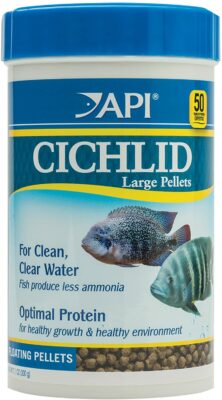
Editor’s Rating:
Why we like it: With the tagline of ‘developing a better underwater world,’ API has been formulating high-quality fish food for over five decades now, the culmination of which brings us the API Fish Food Pellets that tank owners–and their beloved fishes–know and love today.
Quick Facts:
- Type: Pellets
- Buoyancy: Floating
- Food size: 5 mm
- Product weight: 200g; available in 45g and 113g
- Diet type: Primarily carnivorous
The high-quality, nutrient-rich floating pellets of API are suitable for all fishes, cichlids included. It was formulated to contain the exact blend and the right amount of nutrition to keep large cichlids healthy and happy. Special ingredients such as spirulina allow it to enhance color and ensure that your fishes find the food palatable.
A unique aspect of the API fish food is that it has 35% less ammonia than competitors, which means your cichlids also produce less ammonia in general if you feed them with API continuously. Large amounts of ammonia can be hazardous for your tank, so it’s great seeing this from a budget product.
However, note that these pellets are more suited to bigger cichlids, and smaller cichlids may have trouble downing them. No matter how waste-reducing the design, if fishes’ tiny mouths can’t make a dent in the 5mm-sized pellet, then that uneaten food will end up as detritus in the water.
Pros
- Balanced nutritional content
- Improved palatability
- Contains less ammonia
- Reduces waste
- Enhances color
Cons
- Pellets are too large for mid-sized cichlids
- Uneaten pellets cloud the water
4. Best for Enhancing Color: Aqueon Cichlid Pellets
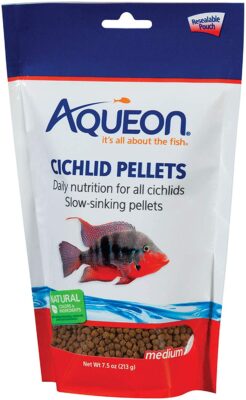
Editor’s Rating:
Why we like it: If you want something that your cichlids are sure to gobble up, then the specially-formulated, color-enhancing, nutrient-rich Aqueon Cichlid Food Pellets might just be the one for you.
Quick Facts:
- Type: Pellets
- Buoyancy: Slow-sinking
- Food size: approx. 3 – 4mm, available in 2 other sizes
- Product weight: 708g, available in 6 other weights
- Diet type: Omnivore
Aqueon’s affordable, slow sinking cichlid pellets are made to be everyday cichlid fare, especially if your main goal is to enhance your pets’ already amazing colors. Not only are there 6 item weights to choose from to fit all sorts of lifestyles and budgets, but you can also choose from mini, medium, and jumbo pellet sizes to cater to any cichlid size available.
Made to be slow-sinking, these pellets give an ample amount of time for top and middle feeder cichlids to feast. In addition to this, Aqueon pellets are made to be naturally palatable to fishes, consisting of fried krill and squid to be more irresistible to fishes. Each pellet contains a blend of chili powder, marigold, and astaxanthin, which naturally brings out bright colors among your cichlids.
One issue we found is that despite being marketed as slow-sinking, these pellets often have difficulty sinking to the bottom by themselves.
Pros
- A wide array of sizes
- Color enhancing formula
- Naturally delicious to cichlids
- All-natural ingredients
- Affordable
Cons
- Some pellets still float
5. Best Crisps: TetraCichlid Cichlid Crisps
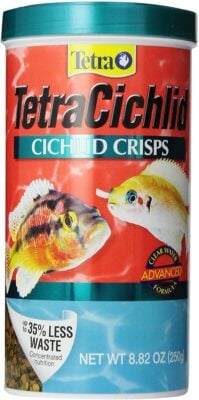
Editor’s Rating:
Why we like it: Another one from Tetra’s unparalleled product lines, the TetraCichlid Crisps provide essential nutrition, color enhancement, and signature feeding convenience for top-and mid-feeding cichlids.
Quick Facts:
- Type: Crisps
- Buoyancy: Floating
- Food size: N/A
- Product weight: 250g, available in 92g
- Diet type: Omnivorous
Slightly thicker than flakes, the TetraCichlid Crisps are specially formulated for top and middle feeders. They stay afloat for much longer than flakes, which gives even the slowest mid-to small-sized cichlids the chance to feed. Dried krill and shrimp, which are irresistible to fishes no matter what their diet is, make up a large part of this fish food.
Every single crisp is made out of concentrated, high-protein, nutrient-rich extracts from algae, and cichlid diets staple, further improved with Tetra’s ProCare Technology and immune-boosting biotin just like the TetraCichlid Balanced Diet Flakes. Even with the high fat and protein content of these crisps, the Clear Water Formulation signature of this product line minimizes water clouding.
However, crisps are not ideal for large cichlids of over 5 inches, as it’s much too small to be properly filling for them. If you have cichlids of that size, we recommend switching to bigger pellets like the Fluval Bug Bites or the API Fish Food Pellets or give your pets a mixture of both. And of course, since this is a Tetra offering, after all, the price is higher than other products on the list.
Pros
- High fat, high protein
- Includes algae-extract and biotin
- ProCare technology
- Clear Water formula minimizes cloudiness
Cons
- Not ideal for large cichlids
- Expensive
6. Best for Bottom Feeders: Omega One Super Color Sinking Cichlid Pellets
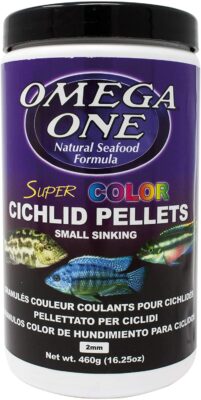
Editor’s Rating:
Why we like it: Omega One prides itself in providing cichlid pellets made directly from freshly-caught Alaskan seafood providing top-quality protein with unparalleled freshness, palatability, and health benefits to cichlids.
Quick Facts:
- Type: Pellets
- Buoyancy: Sinking, available in a floating variety
- Food size: 2mm, available in other sizes
- Product weight: 460g, available in 119g, 226g, and 1.4kg
- Diet type: Omnivorous
Made from fresh seafood such as shrimp, herring, and salmon harvested directly from Alaskan waters, Omega One’s Super Color Sinking Cichlid Pellets are an excellent choice for bottom-feeding cichlids.
These pellets come in four varieties of item weights, three types of pellet sizes, and two varieties of buoyancy, making sure that there’s something for your cichlids regardless of their size. The pellets contain high-nutrient ingredients like spirulina, ocean kelp, and seafood that is more than enough to satisfy the dietary needs of cichlids.They also boast high beta-carotene content, a natural color enhancer for fishes. Each pellet is also chock-full of fatty acids, as well as omega 6 and 3, which all help to provide well-rounded nutrition to your beloved cichlids.
That said, they do sink faster than expected due to their denseness. These pellets are a little dense, though, and they tend to sink quickly once they take on water. This may not give slower top or middle feeding fishes enough time to feed on them. However, you can easily solve that problem by switching to floating pellets or giving your cichlids a mixture of both every feeding time. Pellet sizes are also a lot smaller than usual, even in ‘mini’ sizes.
Pros
- Made from fresh seafood
- Natural color enhancement
- High-nutrient, all-natural ingredients
- Can cater to a wide variety of cichlid species
Cons
- Sinks fast
- Relatively smaller pellets
7. Best for Small Cichlids: NorthFin Cichlid
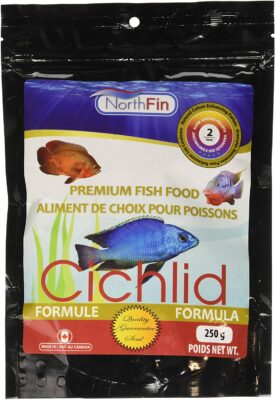
Editor’s Rating:
Why we like it: Your cichlids will surely love the high-protein, vitamin-rich, delicious content of NorthFin’s special cichlid food.
Quick Facts:
- Type: Pellets
- Buoyancy: Slow-sinking
- Food size: 1-3 mm
- Product weight: 113.4g
- Diet type: Carnivorous and omnivorous
Great for both carnivorous and omnivorous varieties, NorthFin’s slow-sinking pellets contain excellent ingredients such as krill, herring, sardine, and kelp. It also contains natural color-enhancing ingredients like spirulina and astaxanthin and minerals like zinc, biotin, and selenium.
In short, it provides all the necessary nutrients for any fish, and even more so for your cichlid. After all, these ingredients have been scientifically known to enhance the growth, coloration, and personality of daily-fed fishes, and you’re going to get all of that as benefits when you opt for NorthFin’s special cichlid food.
The biggest drawback to this product, however, is its size. Even the largest-sized pellet, at 3mm, is much too small for larger cichlid varieties. If you’re keen on feeding this to your beloved pets, you can start while they’re young and move to larger pellets like the Fluval Bug Bites or the Aqueon Cichlid Pellets when they grow bigger.
Pros
- Rich in nutrients, vitamins, and minerals
- Promotes proper growth
- Enhances coloration
- Boosts cichlid immune system
Cons
- Too small for large cichlids
8. Best for Carnivores: Hikari Cichlid Gold Fish Food
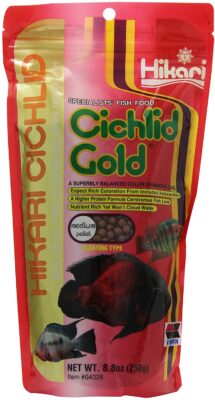
Editor’s Rating:
Why we like it: Hikari has been a big name in the aquarium business for a long time, providing a wide range of species-specific, high-quality, scientifically balanced diet of the best quality fish food for almost 140 years.
Quick Facts:
- Type: Pellets
- Buoyancy: Floating
- Food size: 4.5 to 5.3 mm
- Product weight: 250g, available in 57g, and 10kg
- Diet type: Primarily carnivorous
Although made in sizes appropriate for larger cichlids, Hikari also offers several other species-specific foods in this product line in the form of Cichlid Staple, Cichlid Excel, and Sinking Cichlid Gold, to be able to cater to all kinds of cichlid needs.
The Cichlid Gold is made to be an everyday larger-fish staple that contains all the necessary nutrients for them to have the best coloration and the correct form. These pellets float for the maximum amount of time, allowing even the slowest, lumbering top-feeding cichlid to feed leisurely. Each pellet is rich in nutrients and high in beta-carotene to bring out the best colors and the healthiest life for your cichlids.
That said, even very large cichlids can have trouble fitting the large pellets into their mouths, as the pellets expand a lot when taking up water. To avoid this problem, consider getting one, or even several, sizes down.
Pros
- Available in different pellet sizes and weights
- Floats for a long time
- Contains color-enhancing ingredients
- Product line caters to wide cichlid species
Cons
- Expands a lot in the water
9. Best Floating Sticks: TetraCichlid Floating Sticks
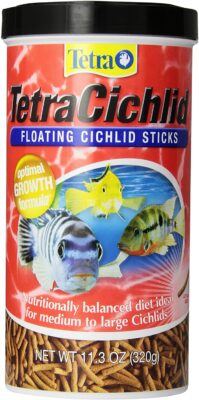
Editor’s Rating:
Why we like it: You probably see a little bias here, but we assure you that with the balanced nutrition, the immune-system boost, and the health enhancement that the TetraCichlid Floating Cichlid Sticks provide, it’s a worthy addition to this list.
Quick Facts:
- Type: Sticks
- Buoyancy: Floating
- Food size: N/A
- Product weight: 320g, available in 75g, 160g, and 3kg
- Diet type: Primarily carnivorous
Tetra’s cost-effective floating sticks contain the appropriate balance of nutrients to improve growth among top feeding carnivorous cichlids. Although there are no precise measurements available, this food is quite large, perfect for larger cichlids. Since it comes in stick form, you can easily break it down into smaller pieces.
It contains a carefully formulated blend of biotin, omega 3, vitamins, and immunostimulants specially designed to boost a fish’s resistance to stress and sickness. Truly a Tetra signature product, it’s also imbued with ProCare Technology for a long and healthy life and the Clear Water formula for reducing cloudiness in the water.
However, fishes tend to make a lot of mess when eating food in stick form, as they have to tear the stick down to fit the food in their mouths. Despite Tetra’s Clear Water formula, the food could break off in chunks and cloud the water, so you have to be careful come feeding time.
Pros
- Cost-effective considering the brand
- Enhances health and coloration
- Contains biotin and other immune boosters
- Provides balanced, everyday nutrition
Cons
- Messy when eaten
- Can cloud the water
10. Most Unique Ingredients: New Life Spectrum Naturox Series Cichlid Formula
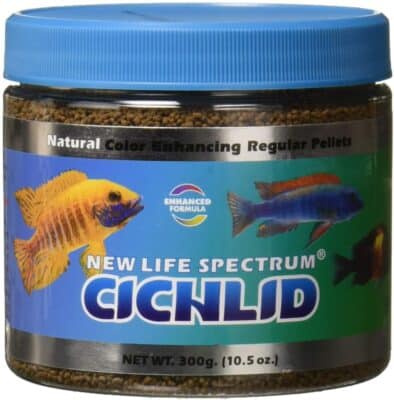
Editor’s Rating:
Why we like it: New Life Spectrum’s newest offering in the Nature product series boasts top-of-the-line ingredients such as whole Antarctic krill, squid, garlic, and even high-mineral bentonite clay geared for the best cichlid feeding experience.
Quick Facts:
- Type: Pellets
- Buoyancy: Sinking
- Food size: 1.0 to 1.5mm
- Product weight: 300g
- Diet type: Omnivorous
Made from premium ingredients, the New Life Spectrum Naturox Series Cichlid Formula features primarily whole, high-protein ingredients such as Antarctic krill and squid and an especially formulated blend of anti-parasitic, immune-boosting garlic.
The added bentonite clay is a wonderful binder and provides all sorts of trace minerals that benefit cichlids. These pellets also contain spirulina, vegetable and fruits extract, and algae meal to provide a balanced set of nutrients, giving your cichlids everything they need for brilliant color and sustained proper growth.
Unfortunately, the sizing is quite unclear, as it doesn’t appear on the labels. The pellets also sink way too fast for most top feeders to enjoy it properly. Compared to other pellets on the market, these ones are much smaller, making them unsuitable for bigger cichlid varieties.
Pros
- High-protein
- Immune-boosting and color-enhancing ingredients
- Well-balanced nutrient content
- Contains trace minerals
Cons
- Unclear sizing
- Sinks way too fast
- Very small pellets
The Ultimate Guide to Cichlid Food
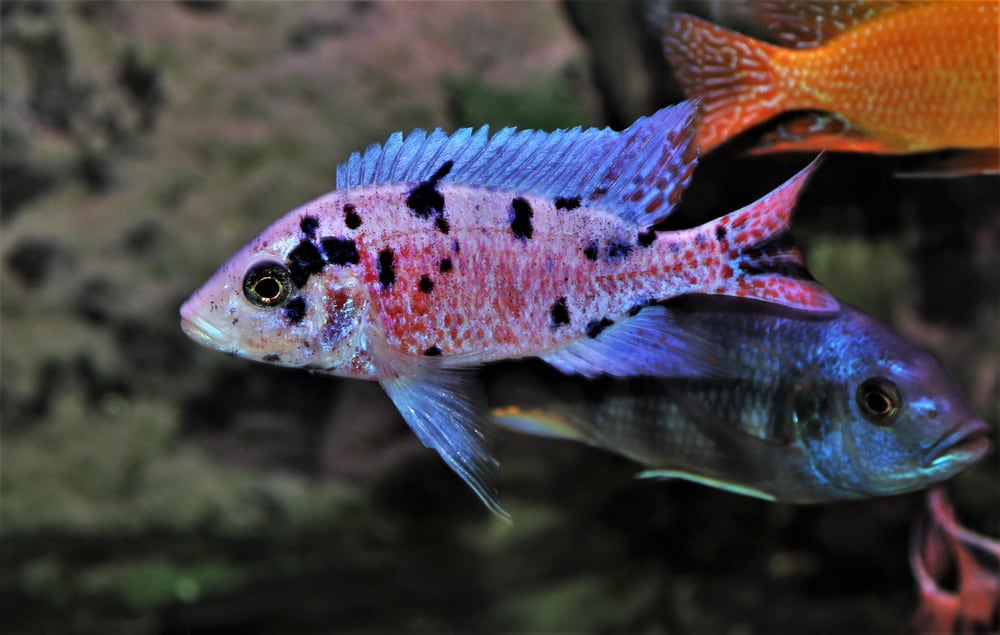
If you’ve reached this far, then you’ve probably already realized that there’s much more to cichlid food than you thought. As you can see, there’s a wide range of products out there, filled to the brim with different nutrients, ingredients, and features.
In the next sections, we’ll tell you everything you need to determine which cichlid food works best for you.
What Makes Cichlid Food Special?
Cichlid food is fish food specially developed for cichlids, rather than just for fishes in general. It might sound simple, but there’s more to it than that.
Sure, you can feed your cichlid standard fish food, and they’d probably be content living off of that. But for them to really thrive in your tank, you need food formulated especially for cichlid species. After all, different species of fish have different nutrient requirements needed to keep them happy. This is because fish species come from different habitats, and therefore their diet is suited to that too.
Cichlids need to have food that reflects their origins. They’ll be much happier if they’re fed the proper nutrition, rewarding you with dazzling coloration and interesting personalities.
Types of Cichlid Food
There’s a wide array of cichlid food available out there, and not all of them are the same. Some float, some sink. Some are good for everyday use, while some you should reserve for special occasions.
To be able to choose cichlid food properly, you must first know what these varieties are. It’s a must to consider their differences to find one that suits your needs, your preferences, and your fishes’ nutritional requirements.
Flakes
Flakes are thin, papery slices of food that float on the water surface. This is the most popular fish food type out in the market, which means that cichlid food in this form is widely available. The biggest disadvantage of this food type is its thinness. Flakes are so thin that once they sink, they tend to break down and dissolve in the water. This shouldn’t be a problem for fast, top-feeding cichlids, though.
Crisps
Crisps are ideal for small to medium-sized top-feeder cichlids. This type is an improvement to flakes, developed to minimize its disadvantages. They are a little bit thicker and thus stay on the water surface lot longer compared to flakes.
Pellets
Pellets are those small, ball-shaped cichlid foods packed with various nutrients. They’re typically further subdivided into three types: floating, sinking, and slow-sinking. As their names suggest, floating pellets tend to stay on the surface of the water, sinking pellets settle at the bottom of the tank, while slow-sinking pellets remain a bit on the surface before eventually falling to the bottom.
Pellets usually come in varying sizes as well, making them suitable for different sizes of cichlids. In fact, our top pick for cichlid food is slow-sinking pellets, that are found in Fluval Bug Bites.
Granules
The only difference between granules and pellets is that granules aren’t round-shaped and are therefore easier for fishes to grip with their mouths and swallow in one bite. Granules are also generally slow-sinking, so middle and bottom feeder cichlids can eat this type of fish food as well.
Tablets
Tablets are made mainly for bottom feeders, as they were designed to take on water easily and sink quickly to the bottom. This is the best kind of food for fish that dwell on the bottom of the tank, such as cichlids who like eating off the ground and other potential bottom-feeder tankmates.
Live Food
Live foods are some of the most expensive and difficult foods to acquire for your fishes. Most pet shops don’t raise and sell live food, so if you really want your fish food live, then you’ll most likely have to do it on your own. In fact, many experienced aquarists prefer raising live foods by themselves, if only to ensure that the food will be fresh and parasite-free.
The cultivation of live fish food varies a lot, depending on what you want to raise. Some of the easier ones to raise are daphnia and brine shrimp. You can also cultivate bloodworms, mosquito larvae, and even live worms.
Frozen Food
Frozen or freeze-dried food is generally made up of preserved live food. They were designed to last longer in preservation while still retaining most of the nutrition that the meat of fresh, live food provides.
There’s a wide variety of frozen food available on the market, from frozen beef liver to brine shrimps and daphnia. We recommend frozen or freeze-dried bloodworms as most cichlid varieties love them.
Important Features of Cichlid Food
This section will tell you all the crucial aspects you should be looking out for when searching for your cichlid’s daily bread.
Fish Diet
As mentioned above, there are many different kinds of cichlids, and they all have diverse diets. There are carnivorous cichlids, herbivorous cichlids, and omnivorous cichlids. Natural selection has made them develop certain physical characteristics to help them survive better in their respective habitats.
For example, carnivores like jaguar cichlids and Jack Dempseys all have short tracks for digestion, which is ideal for breaking down protein and fat. This means that their bodies are adapted to eating meat, be it from insects, crustaceans, or even other fishes, which also live in their swampy lakes and murky freshwater rivers.
Herbivores, like many varieties of African cichlids, have a much longer intestinal tract than that of carnivores so that they can absorb more nutrients from low-protein and low-cat sources such as plants, algae, and biofilm. Cichlids of this type are meant to graze all day.
Lastly, omnivores like Rainbow cichlids, Peacock cichlids, and Firemouth cichlids have an intestinal system in between that of carnivores and omnivores, meant to break down flora and fauna alike for nutrients. These fish would eat pretty much everything that wouldn’t eat them. However, it’s important to note that many cichlids are at least partly omnivorous, as cichlids have no clear-cut diet out there in the wild.
Ingredients
It’s important to determine which primary ingredient answers your cichlid’s dietary requirements. As the tank owner, you should familiarize yourself with your pet’s diet. For instance, carnivores would be thrilled to gobble up insect-based fish food, while herbivores would love to receive plant or algae-based fish food.
You should also pick ingredients that have added benefits for your fish. Omega 6 and 3, for example, enhances cichlid growth. You may also want to pick nutrients that are known to improve color and boost their immune systems, such as marigold and astaxanthin.
Solubility
Cichlid foods have a variety of solubility levels. The more soluble the food is, the easier it soaks up–and dissolves in–water. This could be a problem if you want to keep your tank crystal-clear at all times.
That said, you may want to have foods that easily take in water for your bottom feeders, as this type will sink to the substrate better.
Size
Cichlid food comes in various sizes that cater to their wildly different bodies. This is important to consider as well since the size and amount of food that a cichlid can take in is directly proportional to its size.
For example, small cichlids will have a problem fitting bigger-sized foods into their mouths. Large cichlids, on the other hand, will have difficulty catching ultra-small food particles in the water.
To sum it up, a mismatch in sizes can result in hungry fishes, a dirty tank, nutritional imbalances, or all of these at the same time.
Food Buoyancy
This aspect caters to the feeding zones of different types of cichlid. Ideally, a community tank should have top, middle, and bottom feeders. Each zone has a specific fish food specialized for it.
Floating fish food, like flakes and crisps, remain on the water surface for the longest amount of time, making them more suitable for top feeders. Slow-sinking pellets or granules are best for middle feeders, as this gives them time to eat the food before it lands on the substrate. Lastly, fast-sinking tablets give bottom-feeders the most advantage since it goes straight to the bottom.
How Frequently Should I Feed My Cichlids?
How often you feed your cichlids depends mainly on your cichlid’s size and how active they are. You need to balance your feeding so that your fishes stay healthy and happy.
If you’re a beginner aquarist, we recommend following this simple guide:
- Small: Cichlids that are only 1-3 inches typically have faster metabolism, more energy, and smaller stomachs. These species need to be fed small meals throughout the day, up to 3 times.
- Medium: Species measuring 3-4 inches have better stamina and don’t need to be fed as often. You can feed them two times a day if they’re particularly active.
- Large: Cichlids that are bigger than 4 inches don’t need to be fed as often. In the wild, large predator species are used to not eating every day since their attempts to catch their meals are never guaranteed. In order to avoid overfeeding, you should only give food to these types once a day, or even every other day.
That said, do take note that this is meant to serve as a general guide only. You should always do more research on your specific cichlid variety. A good example would be Kenyi cichlids, which grow up to six inches long. While they can be perfectly happy eating only once a day like other similarly-sized cichlids, research shows that feeding them thrice a day actually has more positive results.
What’s the Ideal Amount of Fish Food to Feed My Cichlids?
Just like the previous question, there’s no single answer to this one either. The truth is, how much food you give to your pets depends on the fishes themselves.
One of the best methods you can try is to dole out food little by little. Start with a single pinch of fish food and wait for your cichlids to consume all of it. Once they’ve finished eating, add some more. Continue adding small pinches of food until they slow down or completely lose interest.
Can I Feed My Cichlids Vegetables?
Most cichlids are at least partially omnivorous and will readily eat veggies. However, you should avoid feeding true carnivores like dwarf cichlids vegetables, as they may just ignore it and end up fouling your tank.
Some of the vegetables that cichlids love to eat are sweet potato, squash, spinach, zucchini, peeled-off peas, and romaine lettuce. Be sure to blanch the vegetables before you feed them to your cichlids. Otherwise, they might be too hard and, therefore, difficult to eat.
Could Bad Diet Be the Reason for My Cichlid’s Color Loss?
Cichlids are highly prized by many tank owners for their magnificent colors. But a bad diet can lead to color loss, especially if your fishes aren’t getting the right balance of nutrients and vitamins. If you want them to really shine, you should feed them with varied, high-quality food that is suited to their species.
That said, the most common reason for color loss is stress. Stress can come from different factors, such as overcrowding in your tank, an especially aggressive tankmate, or low water quality. Be sure to tick off those potential reasons one by one to determine the root of the issue. If you’ve already done so and your cichlids show no improvement, they could be sick or suffering from parasites.
Final Thoughts
With their charming colors and playful personalities, it’s really no wonder why you want to raise cichlids. But just like everything else, they only bloom with the utmost care.
Be sure to think of your cichlid’s natural diet, the nutrient balance, and the type of food you’re getting for them. For a closer look, remember to examine the ingredients, solubility, and size of your cichlid’s food. Choose the best possible diet for your beloved fishes so that they stay healthy and happy. Your cichlids will certainly thank you for it.
